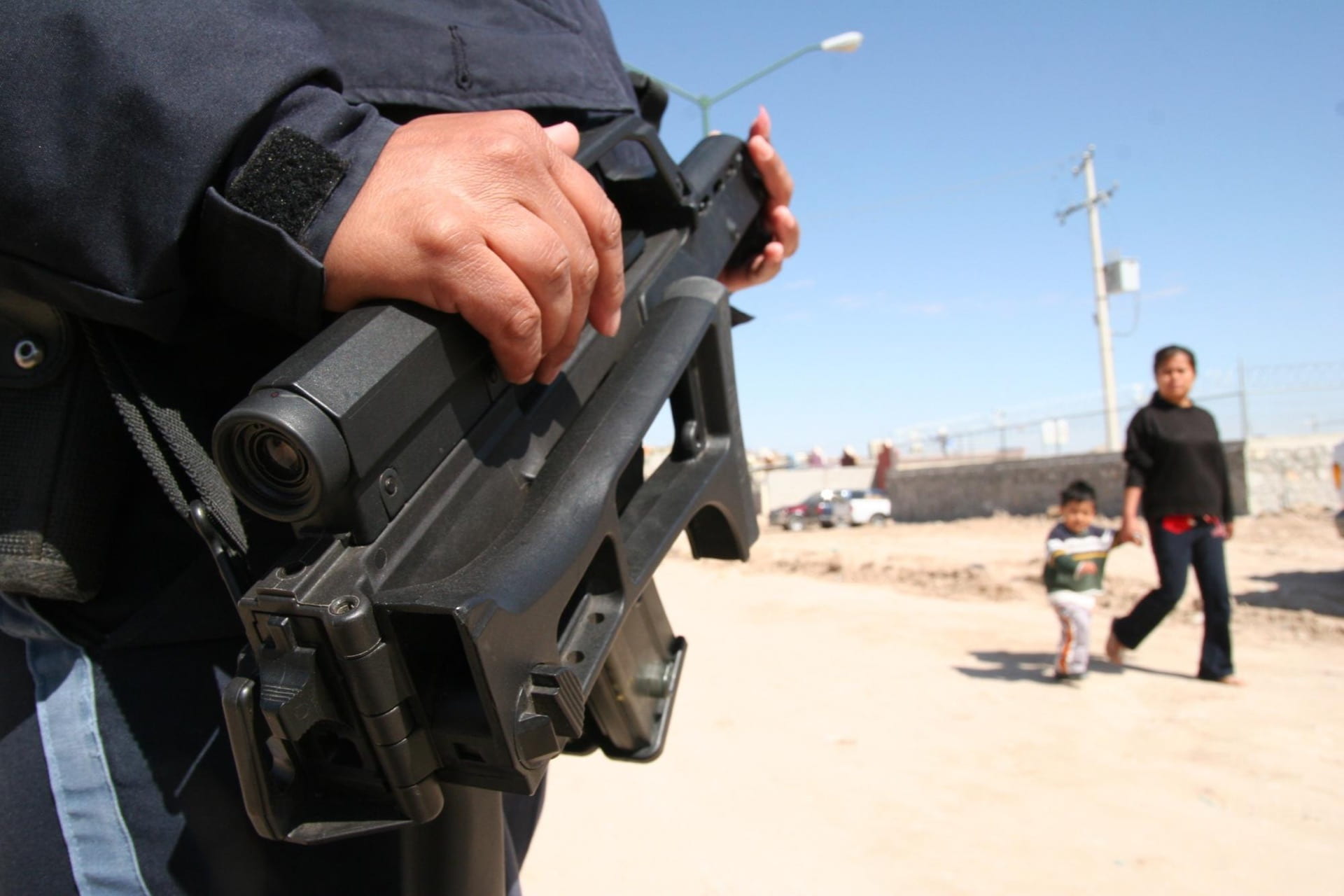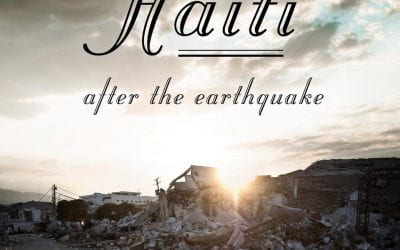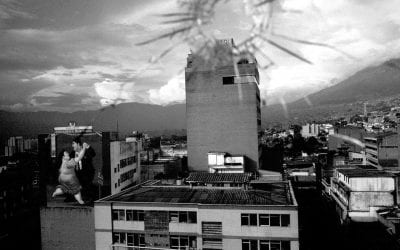Citizen Security in Latin America
Toward a Long Term Solution

March 9, 2009. Juarez, Estado de Chihuahua. A state police commando guards a neighborhood in Juarez. The neighborhood is a scene of a turf war between the Juarez and Sinaloa Cartels over a valued smuggling route to the United States through El Paso, Texas. Photo by Lorne Matalon.
There is no question that throughout Latin America crime and violence have become one of the most important subjects of public debate. And, while it is also beyond question that across the region there are important differences in the patterns of crime from country to country, differences that affect the framework within which the public policy response to criminal activity is formulated, nevertheless, there are crucial similarities in the regional experience which help to understand the nature of citizen insecurity and help to suggest appropriate public policy responses to it.
First the chronology. The concern with crime and violence began to stir public opinion in the 1990s, as the transition to democracy extended throughout the region. Citizen demands, sometimes in the form of demonstrations in the streets, focused on getting the state to use stronger methods to prevent crime —policies known as mano dura o tolerancia cero. In the most extreme cases, Argentina and Colombia, as measured by data from Latinobarometro, citizens expressed doubts about the efficacy of democratic government to provide the protection they wanted. In Colombia, drug trafficking was the excuse to join with the United States to use military force against insurgents and drug cartels. In Central America, conservative elites cited the dramatic increase in gang activity to justify their continued control over the state after the peace process and as a justification for restoring the military to its role as keeper of the domestic peace.
During this period, studying crime and violence became a means to strengthening democratic governance. Throughout the hemisphere, a number of non-governmental organizations (NGOs) focused on the prevention of crime and police reform by emphasizing the need to protect civil and human rights in the process of preventing crime. For example, the work by the Inter-American Institute of Human Rights and the more recent work by the Washington Office on Latin America (WOLA), which began in 2005 and is ongoing.
Throughout the decade of the 1990s, in addition to the focus on how to make sure that citizen insecurity did not undermine new, fragile democracies, there were two other major currents of concern and study. One was an institutional approach that put its emphasis on the reform of the police and the judiciary. The second was an economics-based perspective that examined the high cost of crime with its impact on development, as well as whether crime rates had anything to do with the level of economic development or of poverty. By the end of the decade, the broad consensus among multilateral agencies and students of the subject was that institutional reform was necessary but not sufficient to reduce citizen insecurity; and, that poverty does not cause instability, nor is it associated with poverty in any meaningful manner. The most recent World Bank study reiterates the ambiguity in the data. The preponderance of cases of street or petty crime pits a relatively poor thief against a relatively wealthy victim. However, most of violent crimes involve criminals and victims of the same socioeconomic stratum. And, most compelling, the overwhelming majority of victims of violent crimes are young males. In other words, the Dickensian nightmare of crime caused by poverty, which inevitably led to proposals for a security state that isolated the poor from the less poor, could not be justified. Even so, the media obsession with crime in shantytowns or rumors spread about pockets being picked in middle-class neighborhoods kept the focus of policy-makers on economic questions, which kept zero tolerance policies in the public eye, despite the mounting evidence that such policies in Latin America did not make citizens feel more secure.
Then, in the early years of this century, there was a convergence between studies of police reform and the studies of democratic governance. This led to a more fruitful approach that combined the social and the economic to focus on the phenomenon of exclusion in the society. To get to this multidisciplinary approach and the multi-sectoral response that it suggested for public policy, it was necessary to study the relationship between inequality or income disparities and instability that might provoke criminal behavior. Recent studies suggest that public policy responses are most successful in containing crime or forestalling criminal activity over the long term if they can be aimed at including segments of the population or mitigating their exclusion. The key to understanding how economic factors can drive criminal activity is the difference between inclusion and exclusion in the society.
What are the causes of exclusion and what kind of policy responses would mitigate exclusion, thus reducing the level of criminal activity over time? The most effective policies in reducing the rate of crime will be those that deal with one or more of the following sectoral issues—policies that bring marginal groups or vulnerable groups in the population into the broader society and give them the sense that they have access to the services of the society and can participate more fully in its activities.
Geography and infrastructure are important: there tends to be a powerful geographical manifestation of income disparity. That is, there is a clear separation in the city between the rich and poor, although even in the United States there are pockets of the poor living amongst the super-rich. Policy responses to this situation obviously include infrastructure, especially transportation, and the provision of public (and private) services. Because of space limitations in this article, I will offer only one very simple example. If you examine the metro or subway systems in Santiago, Chile, and Mexico City, D.F., you will find polar opposites in the social impact of the two urban transportation networks. In Mexico, the system is spread throughout the vast expanse of the Federal District and is subsidized so that even the poorest residents of the city can use it. As a consequence, there is no rush hour in the Mexico metro – it is jammed to capacity literally on a 24-hour basis. In Santiago, the metro covers the middle and upper middle class neighborhoods quite well. The cost to use the system is so high that, except for the small morning and evening rush hours when government and financial sector workers go to their offices from their homes in the outlying suburbs and back, the subway cars rarely are crowded.
To take a middle ground, it is interesting to look at Washington, D.C.’s metro system. The planning for the system was begun while the city was still essentially segregated; the first lines performed a social and economic function similar to the system in Santiago. As the city achieved self-government and then a seat without vote in the House of Representatives, the metro system was modified to take the demographics of the city better into account. As a consequence, the usage of the system looks more and more like the system in Mexico with each passing year.
Access to public services is one of the easiest ways to measure the pattern of exclusion in the society, and education is one of the most basic public services. Unequal access to education or unequal quality of education across the space of a city will have a profound impact on the labor market and on social stability. Providing quality education only to a portion of the city’s population certainly would affect the labor market and exacerbate conditions of inequality. When access to quality education is purely a function of the market, the conditions of exclusion become structural and inter-generational poverty is all but guaranteed. Aside from the obvious implications for anger on the part of the excluded, such discrimination also serves as an obstacle to national development. The most successful national policy to reduce the inequality that results from exclusion from education is Brazil’s famous bolsa de familia. Begun during the administration of Fernando Henrique Cardoso and continued by Lula and Dilma, this policy more than any other effort by the state in Brazil, has reduced the degree of inequality and facilitated police reform policies that now allow more active cooperation between those who live in shantytowns (favelados) and the forces of law and order. The current issue in Brazil’s cities (and elsewhere in Latin America) has more to do with organized crime and drug trafficking, which will be discussed below.
Access to the labor market is crucial in preventing crime or, at least, reducing the temptation of vulnerable populations, particularly youth, women, ethnic, indigenous, other minorities, of turning to criminal activity. Informality, so common in poor neighborhoods, especially after the neo-liberal reforms of the 1990s, makes it hard for vulnerable groups to find work that actually keeps them and their families out of poverty. Transportation plays an obvious role in making the labor market accessible to the poor.
Over the past decade, drug trafficking and organized crime have grown significantly. While the production of drugs in Latin America and the transportation of those drugs to the major consumer markets in the United States and Europe are not new, the criminal activity associated with those drugs has spread geographically to the point where every country in the region is affected. Colombia and Mexico suffer more from the activity of drug cartels and traffickers than other countries. However, as criminal activity becomes more organized, it becomes more international and more variegated. Gangs involved in the traffic in drugs tend also to become involved in the illegal traffic in people, especially children and women, arms trafficking and money laundering.
The final chapter of this argument deserves an article of its own. For the purposes of this general survey, suffice it to say that to the extent that criminal activity becomes organized, it tends to become international. And, as the criminal activity becomes international, it requires policies that are international—regional and hemispheric and even global. Increasingly, the traffickers in drugs are using drugs as payment for their activities. This has resulted in exploding consumption of drugs in countries that before had little or nothing to do with the traffic, which makes the exclusion problem more serious than ever.
And, most complicated of all, the traffic in drugs and arms involves dealing with the United States. The hegemonic presumption of the United States makes any mode of hemispheric cooperation difficult. The traffic in arms is sensitive because of the power of the so-called gun lobby. And, the United States is the principal consumer of illegal drugs in the world and yet persists in treating drug consumption as a criminal activity, not a question of public health. Until these complications are mitigated or the nations of Latin America come up with a means of collaborating among themselves without the United States, dealing with illegal organized criminal activity will continue to be a serious problem.
One particular facet of the international dimension of criminal activity concerns all of the nations of the hemisphere. Since the end of the Cold War, realists in the United States and the geopoliticians have been looking for threats to U.S. security. For a while, during the George W. Bush administration, people in the Pentagon thought that the regime of Hugo Chávez in Venezuela was a threat to the United States because of Venezuela’s ties to the rogue regime of Iran. That is no longer a popular view in Washington. However, studies done in Washington and elsewhere speculate that criminal gangs, now focused on the traffic in drugs, or gangs that now earn money committing crimes in the cities of the hemisphere will, at some point, offer their services to terrorists. In such a case, the gangs would make available to terrorists their transportation networks, their services as couriers, and their services as launderers of money to help those whose goals are to wreak destruction in the United States or in some other country of the hemisphere. One such case involving the Mexican-based Zetas and an assassination plot was described in the press in October 2011. The experts are beginning to recognize the linkages between domestic crime and international or transnational crime. In the next few years, the policy proposals must meet the demand for more imaginative approaches.
In order not to close this article on a note of pessimism, I would like to return to the original issue—citizen insecurity in Latin America. In recent work on police reform, experts have come up with the concept of proximity and participation. In dealing with police reform, the policies should focus on mechanisms to reduce the space or distance between citizens and the forces of law and order. It goes without saying that this concept of proximity is another facet of the broader concept of inclusion.
Spring 2012, Volume XI, Number 3
Joseph S. Tulchin, an Associate at Harvard’s David Rockefeller Center for Latin American Studies, was director of the Latin American Program of the Woodrow Wilson International Center for Scholars in Washington for 16 years.
Related Articles
Haiti After The Quake
There is always movement in Haiti. The political, social and ecological terrains are ever-shifting, yet they remain intrinsically connected. Thus the island’s tropical ecology once lured…
Investigating Organized Crime
Medellin, Colombia, February 2009. Two journalists, with more than twenty years of experience between them covering Latin America, were engaging in a familiar lament over a couple of beers. Nobody was paying for serious investigation of organized…
Keys to Reducing Violence in Mexico
Some regions of Mexico now seem like war zones. Nineteen out of the 50 most violent cities in the world are expected to be found in the country by the end of 2011. Yet severe violence is…




